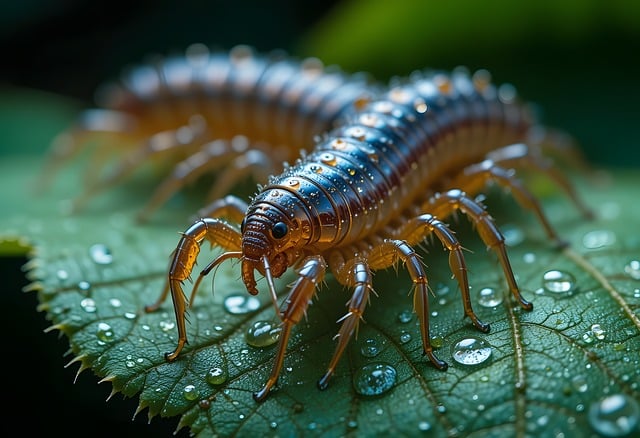Centipedes are drawn to dark, damp areas and cracks in homes, entering through gaps around pipes, windows, doors, and walls. Eco-friendly centipede solutions involve sealing these entry points with non-toxic materials like natural rubber, silicone, and plant oils, reducing pest invasion and creating a greener home. Effective methods include polymer sealants and foams that fill gaps, along with preventative measures like silica gel, diatomaceous earth, regular inspections, and maintaining a clean, dry environment. These solutions offer long-lasting protection without harming pets or the environment, emphasizing their value in modern pest control.
Centipedes are persistent invaders, sneaking into homes through tiny cracks and gaps. Stop their unwelcome entry with our comprehensive guide on professional sealing methods. We explore eco-friendly materials and effective application techniques to fortify against these six-legged intruders. Learn about preventative measures and regular maintenance tips for long-lasting protection from centipede solutions that prioritize sustainability.
Understanding Centipede Behavior and Entry Points
Centipedes are tiny creatures that prefer dark, damp places, making them drawn to cracks and gaps in your home or business. Understanding their behavior is crucial when it comes to sealing entry points effectively. These insects typically move through small spaces, so even minute cracks can provide an invitation for them to enter. They often seek out moisture, making damp areas like basements, bathrooms, and kitchens particularly attractive.
To prevent centipede intrusion, it’s essential to identify their preferred entry points. Common access routes include gaps around pipes, electrical wires, windowsills, doorsills, and any cracks in walls or floors. Eco-friendly centipede solutions focus on sealing these areas with materials that are safe for both the insects and the environment. By blocking their pathways, you can significantly reduce the risk of an invasion and promote a more comfortable living space.
Eco-Friendly Materials for Sealing Cracks and Gaps
When it comes to sealing cracks and gaps to prevent centipede intrusion, there’s a growing preference for eco-friendly materials that are both effective and sustainable. Traditional sealing agents often contain toxic chemicals that can be harmful to both the environment and household pets. In response, manufacturers have developed innovative alternatives using natural resources. These eco-friendly centipede solutions offer a safer approach to pest control while maintaining long-lasting effectiveness.
Natural rubber, silicone-based sealants, and plant-derived oils are some examples of materials that can fill gaps and create an impenetrable barrier for centipedes. Not only do these options reduce environmental impact, but they also ensure the safety of children and pets who may come into contact with them. Moreover, eco-friendly sealing products often have a minimal carbon footprint, contributing to a greener home environment without compromising on centipede control.
Effective Application Techniques for Long-Lasting Protection
When it comes to sealing cracks and gaps to prevent centipede intrusion, choosing the right application technique is key for long-lasting protection. Eco-friendly centipede solutions often involve applying a polymer-based sealant or a specialized foam that creates an impenetrable barrier. These materials are designed to fill and seal even the smallest openings, ensuring no crevice remains accessible to these tiny invaders.
For optimal results, it’s essential to thoroughly clean and prepare the area before application. This includes removing any debris, dust, or existing sealants. Using a brush or compressed air can help achieve a smooth surface ready for the eco-friendly centipede solution. Proper ventilation is also crucial during the process to avoid inhalation of any potential chemicals, making it a safer and healthier option for both your home and the environment.
Preventative Measures and Regular Maintenance Tips
Preventative measures play a crucial role in keeping centipedes at bay. A comprehensive approach starts with identifying and sealing potential entry points. This includes filling cracks, gaps, and any other openings around your property’s foundation, walls, and doors using eco-friendly materials. Using a mix of natural sealants like silica gel or diatomaceous earth can be highly effective in deterring centipedes while ensuring the safety of pets and the environment. Regular maintenance is equally vital; routine inspections should be conducted to identify new cracks and promptly address them before centipedes establish a presence.
In addition, maintaining a clean and clutter-free environment, especially in areas prone to moisture build-up, can significantly reduce centipede attraction. Eco-friendly centipede solutions often involve natural repellents like lemon essential oil or lavender, which can be applied around entry points. Keeping the exterior of your home well-maintained, with proper landscaping and regular weeding, also makes it less inviting for these pests.
In conclusion, effectively sealing cracks and gaps is a powerful strategy in the fight against centipedes. By understanding their behavior and employing eco-friendly materials, you can create a robust defense that blocks these intruders. Utilizing proper application techniques ensures long-lasting protection, while regular maintenance further strengthens your home’s defense system. With these simple yet effective steps, you’ll be equipped to keep centipedes at bay and enjoy a pest-free environment, harnessing the benefits of eco-friendly centipede solutions.
